
Spanish card by La Novela Semanal Cinematográfica, no. 78. Erich von Stroheim.

Italian postcard by Casa Editrice Ballerini & Fratini, Firenze, no. 657. Photo: Metro-Goldwyn-Film, Roma. Mae Murray and John Gilbert in The Merry Widow (Erich von Stroheim, 1925).
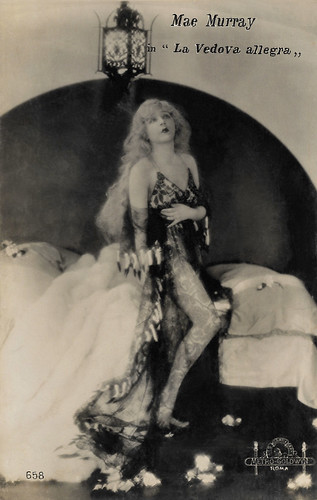
Italian postcard by Casa Editrice Ballerini & Fratini, Firenze, no. 658. Photo: Metro-Goldwyn, Roma. Mae Murray in The Merry Widow (Erich von Stroheim, 1925).

Italian postcard by Casa Editrice Ballerini & Fratini, Firenze, no. 660. Photo: Metro-Goldwyn, Roma. Mae Murray in The Merry Widow (Erich von Stroheim, 1925).
Blind Husbands (1919), The Devil's Passkey (1920) and Foolish Wives (1922)
Erich von Stroheim's directorial debut was Blind Husbands, made in 1919 for Carl Laemmle's Universal. He filmed a script he had written himself about a disastrous love triangle among tourists in the Dolomites. For this film, he also designed the set, did the editing and played a leading role. The film was a great box office success and brought him further directing assignments for Universal Studios.
A digital version of the historical print of Blind Husbands was preserved at the Austrian Film Museum and was released on DVD in 2006 with a musical score by Günter A. Buchwald. 'Il Cinema Ritrovato screened this restoration in 2007'. 'Il Cinema Ritrovato 2022' screened a new digital restoration from 2021. This restoration differs from this DVD release as the image has now been restored, English intertitles were added and the original tinting and toning were digitally reconstructed.
Stroheim's second film, The Devil's Passkey from 1920, is considered lost today, and only a few stills exist. This film was also very successful, so Stroheim was able to indulge in wild and costly extravagances in his next production, Foolish Women (1921).
Blind Husbands (1919), The Devil's Pass Key (1920) and Foolish Wives (1922) formed a triptych of so-called "sex dramas", films about love triangles and adultery. All three films were about an American wife who went to Europe and, thanks to the attention of a European gentleman, became aware of her own sexuality. The role of the gentleman in Blind Husbands (1919) and Foolish Wives (1922) was played by Von Stroheim himself.
Von Stroheim became known as a demanding director, obsessed with details and not afraid to spend money. He often took on multiple roles, including not only director and screenwriter but also actor, film editor and set and costume designer. His reputation was established with Foolish Wives. He paints a vitriolic portrait of a society corrupted by money. As a perfectionist, he demanded that wardrobes and chests of drawers, which were not opened once, be filled with clothes.
Foolish Wives cost almost a million dollars which in 1922 was a considerable sum for a film. Von Stroheim had a life-size replica of Monte Carlo built and frequently filmed on location. The film ended up being Universal's biggest hit to date but managed to make little profit due to the high costs.

Italian programme card for Il Cinema Ritrovata 2007. Photo: Erich von Stroheim in Blind Husbands (Erich von Stroheim, 1919).

German postcard by Ross Verlag. Photo: Universal / Super Jewel. Miss DuPont in Foolish Wives (Erich von Stroheim, 1922).
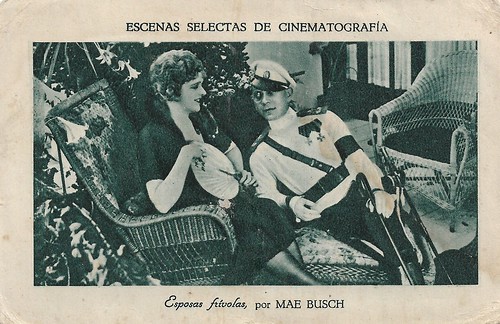
Spanish minicard in the Escenas selectas de cinematografía series, series A, no. 2, for Chocolate Guillèn. Erich von Stroheim in Foolish Wives (Erich von Stroheim, 1922). The lady depicted is not Mae Busch but Miss Dupont.

Big programme card by Cineteca Bologna for Il Cinema Ritrovato, XXXVI edizione, 27 June 2022, Front side. Erich von Stroheim in Foolish Wives (Erich von Stroheim, 1922).
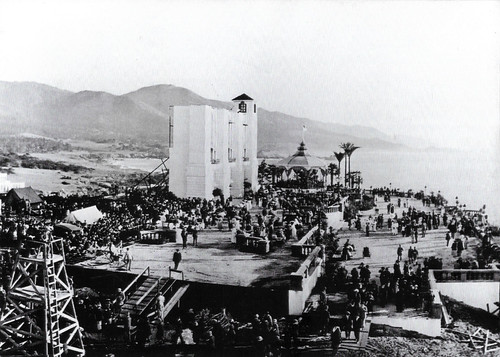
Big programme card by Cineteca Bologna for Il Cinema Ritrovato, XXXVI edizione, 27 June 2022, Flip side. Set Foolish Wives (Erich von Stroheim, 1922).
Merry-Go-Round (1923) and Greed (1924)
Erich von Stroheim's films were also known for the slow pace at which the story was told. Because of this, Universal, under production head Irving Thalberg, often left the editing to other people. Foolish Wives was a third shorter than Von Stroheim actually intended. Halfway through the production of his fourth film, Merry-Go-Round (1923), he was fired by Thalberg.
He had once again not adhered to the studio's specifications. Von Stroheim ordered the necessary military uniforms in Vienna because in his opinion this was the only way to portray the necessary authenticity. He had extras who appeared as soldiers drill for days until he was satisfied with the shots. He had the Prater in Vienna recreated in great detail on the studio lot. Von Stroheim was replaced by Rupert Julian and he left for Goldwyn.
His best-known film is maybe his fifth, Greed (1924), an adaptation of the novel 'McTeague' by Frank Norris. This film is now considered Von Stroheim's masterpiece. The version of the film edited by Von Stroheim followed the novel very closely. This led to a 42-reel version, lasting more than eight hours. Von Stroheim, however, had to contend with Irving Thalberg again, who became his boss when Goldwyn merged with Metro (where Thalberg was working at the time).
Thalberg demanded that Von Stroheim shorten the film. The new version included 24 reels, still too long for theatrical release. Rex Ingram shortened the film to an 18-reel version. Eventually, a ten-reel version lasting just over two hours was released in cinemas, much to Von Stroheim's dismay.
This version received mixed reviews from critics and was not a success in cinemas. The few who had seen the original, complete version said it was one of the greatest masterpieces in film history. However, this version has been lost and probably destroyed.
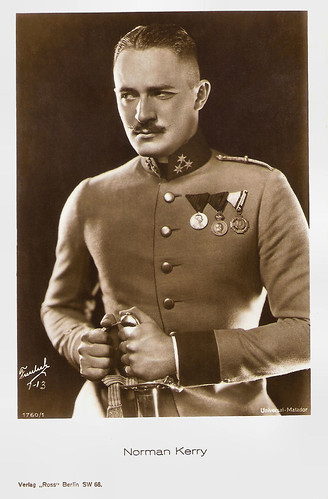
German postcard by Ross Verlag, Berlin, no. 1760/1, 1927-1928. Photo: Freulich / Universal-Matador. Norman Kerry in Merry-Go-Round (Rupert Julian, Erich von Stroheim, 1923).

French postcard by Cinémagazine-Edition, no. 401. Photo: Roman Freulich. Norman Kerry in Merry-Go-Round (Rupert Julian, Erich von Stroheim, 1923). Norman Kerry's surname is misspelt on the card as Keery.

American postcard. Photo: Universal. Norman Kerry in Merry-Go-Round (Erich von Stroheim, 1923).
The Merry Widow (1925) and The Wedding March (1928)
For MGM, Erich von Stroheim made The Merry Widow, starring Mae Murray and John Gilbert as the romantic couple Sally O'Hara and Prince Danilo. It was an adaptation of Franz Lehár's operetta. He hijacked the operetta to make a film about orgies in a royal court with cripples, sex addicts and degenerate monarchs. The film was a huge success.
Von Stroheim made his next film for Paramount, The Wedding March (1925). Von Stroheim had also seen these films as part of a triptych, with Merry-Go-Round as the first part, about decadence in the Habsburg Empire.
Due to the great success of The Merry Widow, Stroheim was given a free hand again and was initially able to shape the production of The Wedding March at Paramount entirely according to his own ideas. Again, however, he exceeded the planned shooting time and budget to such an extent that filming was abandoned.
The Wedding March was also far too long to be released in cinemas and was released in two parts, with the second part being shown as a stand-alone film, The Honeymoon. Today, only the first part exists. The second part, The Honeymoon, is considered lost. The sole surviving print of The Honeymoon was destroyed in a fire at the Cinémathèque Française in 1957, five days after Stroheim’s death.
Rebecca Peters at the San Francisco Silent Film Festival website: "In 1997, Kevin Brownlow and Patrick Stanbury of Photoplay Productions undertook a restoration of The Wedding March, inspired by Fay Wray’s vivid account of the production. Working with the Library of Congress, they have produced a print that matches the re-edited version created by Erich von Stroheim at the Cinémathèque Française in 1954."
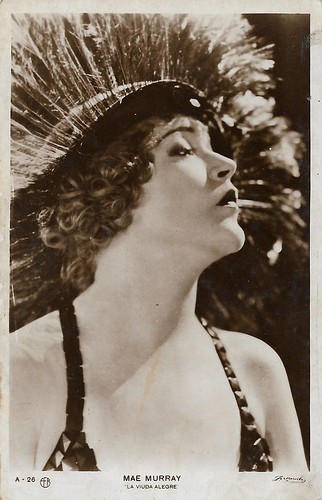
Spanish postcard by EFB (Editorial Fotografica, Barcelona), no. A-26. Photo: Zerkowitz. Mae Murray in The Merry Widow (Erich von Stroheim, 1925).

German postcard by Ross Verlag, no. 1319/1, 1927-1928. Photo: Loew Metro Goldwyn. John Gilbert in The Merry Widow (Erich von Stroheim, 1925).

French postcard in the Les Vedettes de Cinéma Series, by A.N., Paris, no. 369. Mae Murray [the trema is a mistake] and John Gilbert in The Merry Widow (Erich von Stroheim, 1925). The film was a huge success.
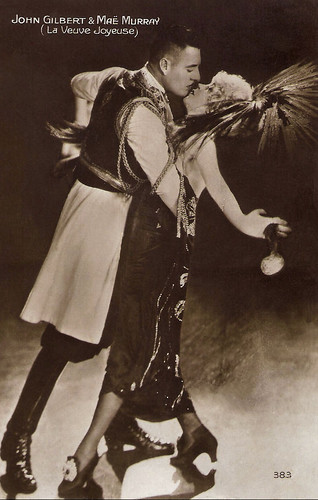
French postcard by Cinémagazine-Edition, Paris, no. 383. Photo: Metro-Goldwyn-Film. John Gilbert and Mae Murray in The Merry Widow (Erich von Stroheim, 1925).
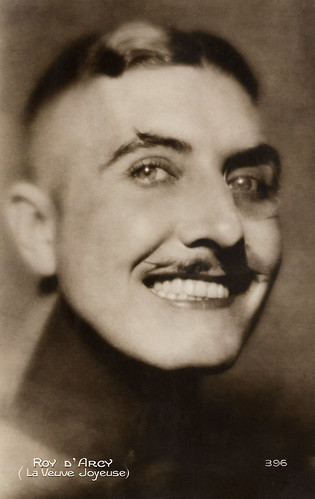
French postcard by Cinémagazine-Edition, Paris, no. 396. Photo: Roy d'Arcy in The Merry Widow (Erich von Stroheim, 1925).
Queen Kelly (1928) and Walking down Broadway (1932)
Erich von Stroheim's last film was Queen Kelly in 1928. Stroheim used up countless hours of footage for the prologue alone. Due to friction with leading actress and producer Gloria Swanson, Joseph Kennedy, Swanson's co-producer and partner, forced the director to leave. Kennedy declared: "Stroheim must never be allowed to direct a film again".
Swanson had a few more scenes shot without Von Stroheim to bring the plot to a close. However, this version was only shown a few times in Europe and then disappeared into the archives. A restored version of the existing material according to Von Stroheim's original plans was only made available to the public in 1985.
His reputation as a director was ruined as a result, and Von Stroheim was forced to return to the camera as a performer for other directors. In 1929 he played the title role in his first sound film, The Great Gabbo by James Cruze. Just like at the beginning of his career, he was now often seen again as a villain in supporting roles. During this period, Von Stroheim was also frequently forced to work as a technical advisor and assistant dramaturge.
All of Von Stroheim's films were silent movies. Fox allowed him to direct the sound film Walking Down Broadway in 1932, but the film was entirely re-edited on the orders of producer Sol Wurtzel and enhanced with new scenes shot by Alfred Werker, Raoul Walsh and Edwin Burke. The final version was released in 1933 under the title Hello, Sister.
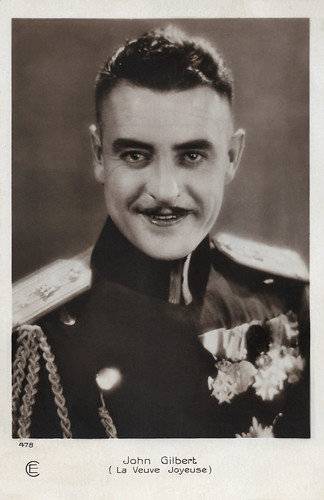
French postcard by Cinémagazine-Edition, Paris, no. 478. Photo: Metro-Goldwyn-Film. John Gilbert in The Merry Widow (Erich von Stroheim, 1925).

Austrian postcard by Iris Verlag, no. 559. Photo: Metro-Goldwyn-Film. John Gilbert and Mae Murray in The Merry Widow (Erich von Stroheim, 1925).

Italian card for the Il Cinema Ritrovato festival. Photo: Fay Wray and Erich von Stroheim in The Wedding March (Erich von Stroheim, 1928).
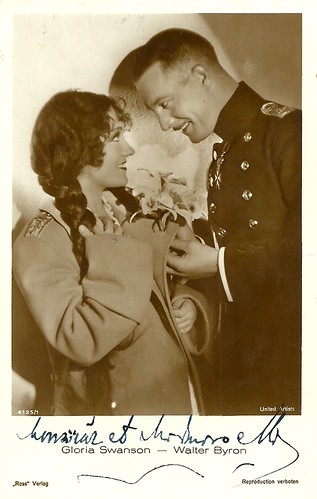
German postcard by Ross Verlag, no. 4125/1, 1929-1930. Photo: United Artists. Walter Byron and Gloria Swanson in Queen Kelly (Erich von Stroheim, 1929).
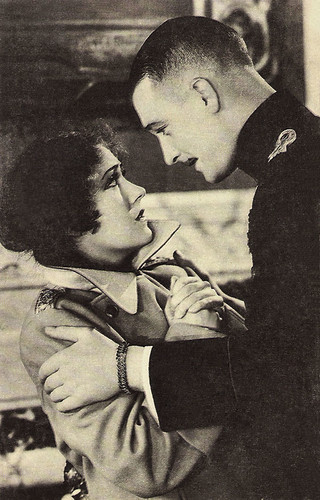
Spanish postcard by Casa Molina, Madrid. Gloria Swanson and Walter Byron in Queen Kelly (Erich von Stroheim, 1929).
Sources: Rebecca Peters (San Francisco Silent Film Festival), Film Museum Austria, Wikipedia (Dutch, French and German) and IMDb.
This post was last updated on 3 July 2022.
No comments:
Post a Comment